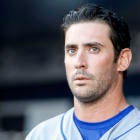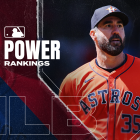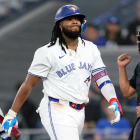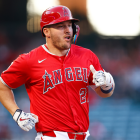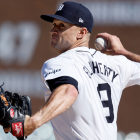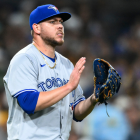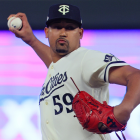We're all guilty of this, of course. When it comes to evaluating our favorite team's players, we're often unable to achieve a sensible remove. This is particularly the case when talking about prospects or established veterans on the outs. The Mets right about now have a prominent example of the latter.
Time was when right-hander Matt Harvey looked like the most promising within that impressive stable of young pitching. The seventh overall pick back in 2010, Harvey cut a swath through the minors and at the highest level pitched to a 152 ERA+ and 4.58 K/BB ratio across his first two seasons. Deeply impressive outputs, those.
But then, for a panoply of reasons, Harvey's career went off course. The most recent plot-twist has been his apparent AWOL status and resulting suspension. If a recent New York Post/Page Six report is to be believed, then Harvey didn't show up at the ballpark Saturday not because he had a migraine after golfing, but rather because he was out drinking until 4 a.m. the night before. Whatever the truth, it's the latest example of Harvey being at unnecessary loggerheads with his employer.
Because of Harvey's current pariah status and his once-abundant promise, Mets partisans might be inclined to think that dealing Harvey could net a significant return for the team. Yes, his value is dinged by recent events, but he's still a 28-year-old with a big name and a past record of near-dominance. Right?
The instinct is understandable and just about universal, but in this instance it's dead wrong. Scuttle and wish-casting aside, the Mets aren't going to get anything of value in return for Harvey. Here's why ...
He's got a grim health history
First, Harvey is a veteran of Tommy John surgery. He underwent that procedure in October 2013. Harvey rebounded to enjoy a mostly successful 2015, but the reality is that he's on his second ulnar collateral ligament. What's of greater concern is that Harvey was shut down in early July last year with shoulder problems and eventually underwent surgery to correct thoracic outlet syndrome. That particular malady isn't as much a part of the baseball consciousness as a shredded UCL, but there's reason to believe it's more serious. TO syndrome isn't particularly common, but it's a potential career-ender. More generally, major shoulder problems pursuant to major elbow problems aren't a promising sign. Speaking of which ...
He's been a bad pitcher in 2017
Since Harvey's peak season in 2013, when he finished fourth in the NL Cy Young balloting, he has lost two full ticks off his average fastball velocity. Yes, most pitchers start leaking velocity early in their careers, but this is steep even by those standards. At the same time, Harvey's performance has declined badly (bear in mind he missed the 2014 season while recovering from Tommy John surgery) ...
| Season | ERA | Strikeout percentage | Hard-hit percentage | Average fastball velocity |
|---|---|---|---|---|
2013 | 2.27 | 27.7% | 26.5% | 96.96 |
2015 | 2.71 | 24.9% | 26.7% | 96.46 |
2016 | 4.86 | 18.9% | 30.3% | 95.39 |
2017 | 5.14 | 13.5% | 34.5% | 94.95 |
That's a precipitous and broad-based pattern of decline. Yes, the 2017 sample size is quite small, but the trends are there. He's not throwing as hard, he can't strike out hitters, he's getting squared up and he's permitting runs like never before. Look at these numbers and you would immediately think injury.
Harvey, though, has already been injured in two very serious ways. It's fair to ask whether he's ever going to recapture anything close to his peak capabilities. Teams like calculated risks. They don't much like long shots.
He has off-the-field issues
You know this, of course. It's more than "just" the current palace intrigue, though. While Harvey was recovering from Tommy John surgery, he butted heads with the team over where he would conduct his rehab. They wanted him at the team complex in Florida. He wanted to stay in New York. The two sides eventually struck a compromise. Along the way, Harvey and the team also seemed at odds over when he would pitch again and how much he would pitch upon his return.
Then there's this latest thing. To be sure, because it's Harvey and it's New York, all of this gets more play than it would under other circumstances. There's no doubting, though, that it's not a winning look to show such a lack of commitment in the face of ongoing decline. Any team considering a trade for Harvey will make his questionable dedication to craft part of their calculus and, more to the point, as a cudgel to reduce the asking price.
He's no longer cheap
Harvey is in his second year of arbitration eligibility and is under contract for $5.125 million for 2017. That's cheap relative to the going rates for starting pitchers on the market, but it's roughly five times what Harvey was making during his pre-arb years of "deep" team control. His salary will rise in 2018, and then he's eligible for free agency. He's a Scott Boras client, and history suggests that Boras clients test the market as soon as possible. Yes, the Mets can make Harvey more appealing by kicking in cash, but the Wilpon family, post-Bernie Madoff, doesn't exactly play fast and loose with the coffers. According to quick-and-dirty FanGraphs measures, Harvey thus far in 2017 has been worth -$1.5 million in market dollars. Yes, that's a negative sign. For reasons laid out above, the outlook for substantial improvement isn't strong.
So Harvey is bad, burdened by questionable dedication and no longer cheap. That's not a player you trade in exchange for anything of worth. That's a player you abide or cut loose. Absent sustained improvement from Harvey upon his return, that's the path ahead for the Mets and their crumbled cornerstone.













